Tanah Abang
Tanah Abang (English language : Brother Land or Red Land) is a subdistrict of Central Jakarta, Indonesia. The subdistrict hosts the biggest textile market in Southeast Asia, Tanah Abang Market. Tanah Abang subdistrict is also the location of Bung Karno Stadium (in Kelurahan Gelora) and the western half of the Sudirman Central Business District.
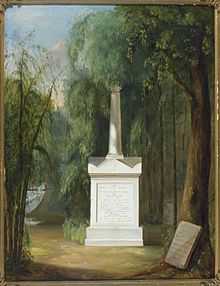
Tanah Abang is also the name of two historic roads located in Kelurahan South Petojo, Gambir Subdistrict. One of this road, Tanah Abang 1 Road, is known as the location of a former Dutch Cemetery, now a museum called Museum Taman Prasasti. The cemetery is the burial place of Olivia Mariamne Fancourt, wife of Stamford Raffles.[1]
The Textile Museum, generally known to be located in Tanah Abang Subdistrict, is actually located in West Jakarta (Kelurahan Kota Bambu Selatan, Palmerah Subdistrict). The museum is identified with Tanah Abang Subdistrict because it is located close to the boundary of the two subdistricts.
Toponym
According to Tota M. Tobing,[2] there is a presumption that the name Tanah Abang[3] was given by the Mataram army troop when they raided the City of Batavia in 1628. During the raid of Batavia, the city was attacked from the coastal area in the north, and from overland in the south. It is possible that the Mataram army troop named this southern area Tanah Abang because the soil (tanah) of the place was reddish (abang is red in Javanese), thus tanah abang means "red soil" in Javanese.
Other presumption is that the name Tanah Abang was given by the Javanese people who stayed in Banten and worked for Phoa Bingham (or Bingam), a Chinese captain, when they cut the forest there in 1650.[4]
Tanah Abang market

Tanah Abang market is located in the Kelurahan Kebon Kacang. The Kelurahan is served by the Tanah Abang railway station,[6] which is located in the western border of the administrative village. The market has been known to exist since 1735.[7] Tanah Abang market is the main textile trade in Indonesia and the biggest in Southeast Asia. Before 2003, the market is divided into three areas, known as Metro Tanah Abang, Tanah Abang Lama, and Tanah Abang AURI. A small part of the market was destroyed by the fire in February 2003. Since 2003 the market has been rebuilt. Other market areas, Blok A and Blok B, were added to the area in 2005 and 2010.[8] Blok A is the biggest among others with 160,000 square meter with almost 8,000 kioks, is visited about 80,000 buyers in busy days with transaction about Rp 500 billions ($43 millions) per day and has well known in Africa and Middle East.[9]
Kelurahan (Administrative Villages)
The subdistrict is divided into seven Kelurahan (Administrative Villages):
- Bendungan Hilir: area code 10210
- Karet Tengsin: area code 10220
- Kebon Melati: area code 10230
- Kebon Kacang: area code 10240
- Kampung Bali: area code 10250
- Petamburan: area code 10260
- Gelora: area code 10270
List of important places
- Gelora Bung Karno Stadium
- Hotel Grand Indonesia (western extension)
- Jakarta Convention Center
- Petamburan Cemetery
- Senayan City
- Tanah Abang market
- Wisma 46
Gallery
-

Tanah Abang Market cir. 1900
-

KH Mas Mansyur Street, Tanah Abang. February 21, 2010
-
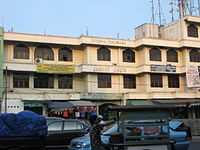
Madrassa Jamiat Kheir, 2008
-

Flood Canal Bisecting Pasar Tanah Abang
-
Busy day at the popular district of Tanah Abang on the outskirts of Batavia, September 1, 1946
-

Tanah Abang, Batavia on May 14, 1929
-

Kali Tanah Abang, cir. 1860-1872
-

Tanah Abang in around 1890-1920
-

Chinese grave in Tanah Abang, 1870-1900
-
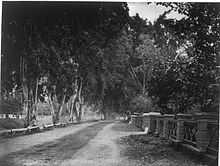
Tanah Abamg, circa 1870
-

Driveway along Tanah Abang Creek, Batavia. 1860-1880
-

Tanah Abang Creek being improved.
-

Bridge over the Tanah Abang Creek, Batavia. 1890-1920
-

Two Dutch men on tennis court in Tanah Abang, 1947
-

The district Tanah Abang, located west of the Bishop's Square, circa 1875-1885
-

People catch fish in the stream of Tanah Abang Creek in Weltevreden (now Gambir area) in Java
-
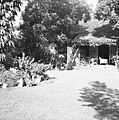
Garden behind the house of J. H. Ritman on Tanah Abang in Jakarta Barat 36 in 1955
-
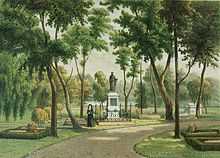
The European cemetery on Tanah Abang 1 (now Taman Prasasti Museum) with the monument of the priest Van der Grinten | 1881-1889
-

Maud Ritman, wife of J. H. Ritman, at her home in Tanah Abang in Jakarta Barat 36
-
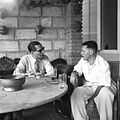
Two men in conversation at the home of J. H. Ritman on Tanah Abang Barat 36 in 1955
-
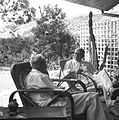
Two men, including J. H. Ritman, in conversation at the home of Ritman at Tanah Abang in Jakarta Barat 36 in 1955
-

A batik maker with batik stempel to work in a state of batik manufavturing in Tanah Abang, cir. 1910-1930
-

Batik makers at work on a batik stand in Tanah Abang, 1910-1930
-

Batik makers in Tanah Abang Market, cir. 1910-1930
See also
References
- ↑ "Tanah Abang (Indonesian)". DISKOMINFO Kota Administrasi Jakarta Pusat. pusat.jakarta.go.id. Retrieved 2009-12-18.
- ↑ Intisari magazine, August 1985
- ↑ Tanah Abang
- ↑ http://www.scribd.com/doc/6516621/Asal-Usul-Nama-Tempat-Di-Jakarta
- ↑ Tanah Abang
- ↑ Krismantari, Ika and Multa Fidrus. "The vulnerable miss out during exodus". The Jakarta Post. Tuesday September 7, 2010. Retrieved on September 16, 2010. "Based on The Jakarta Post’s observations at Tanah Abang train station, Central Jakarta,"
- ↑ http://tanahabangonline.com/index2.php?option=com_content&do_pdf=1&id=71 (Indonesian)
- ↑ http://tanahabangreview.com/2010/09/03/sejarah-tanah-abang/
- ↑ "Weekly 5: The tallest, largest and longest". February 28, 2014.
| ||||||||||||||||||||||||||||||||||
